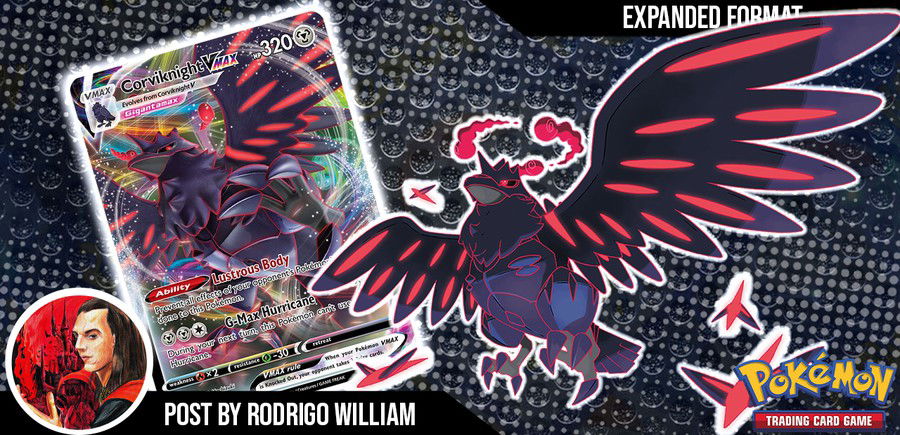How does the Gym Leader Challenge work?
In this article, I explain the Gym Leader Challenge (GLC) format with a guide to example decks. This is a format recently created by fans, mainly by the player Andrew Mahone, who is from the United States and a veteran of the format for years, in addition to being a very present figure in the community, participation as a player in official competitions and content creation.
If you want to check out more details about this and other formats, just click here.
Ad
The format consists of using "baby" Pokémon and their potential, as it used to be with cards in the "Wizards of the Coast era", that is, without having ultra-rare cards such as "ex", "Lv.X", "Prime ”, “Legends”, “EX”, “M. EX", "BREAK", "GX", "Tag Team-GX", "V", "VMax", "VStar", "VUnion" and any other card that contains "Rule Box" such as "Prism Star" and "Radiant”.
What should a GLC deck have?
► Every deck needs to have 60 cards.
►Basic Energy is unlimited, but other cards can have a maximum of 1 copy of the same name. What we also call singleton format.
► The deck needs to have only one archetype, in short, it cannot use breaches with two or more types.
Regarding dual typings, Volcarona STS 15 is accepted, as long as you choose which archetype of your deck will predominate, whether it will be grass (G) or fire (F); Pokémon that do abilities like Gallade CEC 82, can only be inserted in Psychic-type, in the same way as Blaziken DAA 24, which can only be inserted in Fire-type.
Victory Conditions
► Draw all six prize cards.
► Defeat an opponent's Pokémon, and they don't have any on the bench to continue the game.
► If the opponent suffers “Deck Out”, that is, deck exhaustion.
GLC banned list
Its variety philosophy is similar to the Expanded format, but with a number of limitations, such as not using ultra-rare cards like “ex”, “Lv.X”, “Prime”, “Legends”, “EX”, “M. EX", "BREAK", "GX", "Tag Team-GX", "V", "VMax", "VStar", "VUnion" and any other card that contains "Rule Box" such as "Prism Star" and "Radiant", for Pokémon. Trainers with the “Prism Star” rarity are also banned.
- Lysandre's Trump Card PHF 99 (effective 11/16/2021)
- Oranguru UPR 114 (effective 11/16/2021)
- Forest of Giant Plants AOR 74 (effective 01/10/2022)
- Chip-Chip Ice Axe UNB 165 (effective on 06/08/2022)
- Hiker CES 133 (effective 06/08/2022)
- Kyogre SHF 21 (effective on 11/11/2022)
- Pokémon Research Lab UNM 205 (effective on 11/01/2023)
- Raikou VIV 50 (effective on 09/01/2024)
- Marshadow SLG 45 (effective on 09/01/2024)
- Duskull CEC 83 (effective on 09/01/2024)
Decks to play Gym Leader Challenge
I will present some lists that will serve as a guide so that you, the reader, if you are interested, can use them as a basis to build your own deck! Some cards, such as Cynthia, Coloress, Marnie and N are “Staple” cards in format, and therefore may appear frequently.
Grass Box
The proposal is simple: Venusaur SLG 3 enters with its ability to duplicate the effects of the basic grass energy so that then one energy becomes the effect of two and thus, the other Pokémon can attack, and that's where their energization comes in with the ability of Rillaboom SHF 13.
The more Energy in play, with the virtual possibility of Venusaur's effect, Sceptile CES 10 can hit 20 times the amount of Grass Energy attached to all of your Pokémon.
As an alternative attacker, we have Torterra BRS 8 that hits 50 times for each Pokémon evolved in your game. As most have more than one stage, it is possible for us to deal at least 200 damage with ease.
Ad
Fire Box
In the same vein as grass Pokémon with basic energy doubling (such as Venusaur mentioned above), Charizard PGO 10 does the same thing with its ability.
Here the disposal of fire energies is constant, and since you can only have one copy of each card to recover energies, we will not be able to use two Fire Crystal UNB 173. With that, the deck enters a constant energy recycling system with the ability of Blaziken DRM 6, so that it removes from discards and attaches it to one of your Benched Pokémon, being transferred to the Active Pokémon with Armarouge sv1 41.
With this synergy, we have attackers Heatmor FST 41 and Volcanion UNB 25 to fulfill the role, since, with low energy, they deal a lot of damage.
Water Box
Here you have the facility of Blastoise BCR 31 to bring basic water energy mobility from your hand to your Pokémon and in any way you want. This deck has the functions of "Spread and Sniper", that is, it spreads damage and gives targets to opponents, with Kyurem NVI 34 that causes 30 damage to all the opponent's Pokémon or even Kyogre PRC 53 that does 80 damage to your opponent's Active Pokémon and 10 damage to all their Benched Pokémon.
Also enters the evolutionary line of Horsea BUS 29, Seadra LOR 36 and Kingdra BUS 31 which are the finishers, where Kingdra can cause 90 damage with a single energy.
It is possible to use Cryogonal EVS 43 to power up Piplup UPR 31 with Rare Candy PGO 69 to evolve it into Empoleon DEX 29 and hit 10 times the amount of Pokémon that are in play (both yours and the opponent's), dealing 120 damage for just one energy!
Lightning Box
As with any good Electric deck, there should be charge from discards for your Pokémon, - and we're consistent with Flaaffy EVS 55 and Eelektrik NVI 40, with their abilities that power up Benched Pokémon. At the same time, the deck works with “Spread” as well, with Tapu Koko PR-SM SM30.
As a finisher, we have the Shinx RCL 60 evolutionary line, which is great and becomes aggressive to the point that the opponent has 3 prizes left to win the game, increasing its damage. Evolving into Luxray BRS 51, it does 50 times the damage for each Energy attached to all the opponent's Pokémon, and is a good sniper, dealing 110 damage to the opponent's Active Pokémon and 30 to Benched Pokémon for just one energy!
And to close constant damage and counters, we have the Ampharos DRX 40: every time the opponent goes to energize his Pokémon, that Pokémon takes 3 damage counters. This helps to undermine the opponent.
Fighting Box
This archetype takes advantage of its own collateral damage from its Pokémon's brute strength to become its attacking force. Like, for example, damage from Whiscash RCL 100 that does 140 damage to your opponent's Active Pokémon and 20 damage to the Benched Pokémon, Donphan VIV 87 that does 120 damage to the Active Pokémon opponent's, but it does 20 damage to all your Benched Pokémon.
Ad
This empowers the Galarian Runerigus RCL 102 that uses its damage counters to return to the opponent as a "curse"; and even the evolutionary line of Mankey with Primeape BST 67 which does 50 times the damage for each damage counter on your Pokémon in play, and can easily reach 300 damage, and its evolution with Annihilape sv1 109 which does 70 times the damage for each Prize card the opponent took, so 70 x 5 = 350 damage!
Psychic Box
Here, the strategy is pure "Spread Sniper". The focus is on spreading out as much damage and damage counters as possible, and for that, we have the Weezing UNB 74 and Dragapult RCL 91, and as an aid, the stadium Old Cemetery CRE 147, that whenever any player attaches an Energy card from their hand to one of their non-Psychic Pokémon, put 2 damage counters on that Pokémon.
As they are Pokémon with low psychic energy costs, Gardevoir NXD 57 enters with the same principles as Venusaur for grass and Charizard for fire: the ability to double energy psychic basics, and with stadium support from Dimension Valley PHF 93.
For damage finishing, we have the Blacephalon CEC 104 which can vary with markings of 4 counters and 12 counters if the opponent has 3 exact prize cards, and with the game undermined, Mimikyu LOR 80 comes in as a finisher by dealing damage proportionally to counters in play.
Dark Box
Here the proposal is also to cause ”Spread” and combine with the possibilities of poisoning the opponent.
For ”Spread” we have Absol ASR 97 which does 10 damage to all the opponent's Pokémon; and in case there is a way to increase more counters, we use the Sableye UNM 133 which does 10 damage, but if at any time it is hit by attacks (even if it is knocked out in the process), it deposits 8 counters in the Pokémon that dealt the blow. This will contribute to the Honchkrow GRI 79 that deals more damage according to the number of counters, in addition to also having a "sniper" attack.
We also have Crobat SIT 105 that with his second attack, even causing 10 damage, if they knock a Pokémon out with this attack, you take 2 more prize cards from the opponent, in addition to also having the first attack that poisons.
And speaking of poison, we have Toxapex SIT 115 that hits 130 damage for one energy if the opponent is poisoned, and we still have Galarian Weezing RCL 113 as a great support for poison and counters, in addition to locking skills.
Metal Box
Here the objective is to move energies to your metallic attackers. Knowing that heavy Pokémon like Aggron UNB 125 will hold the game with counterattacks, you can lose those energies with it, because it requires 3 to 4 of them, so you will use Bronzong BST 102 for the transfer and Magnezone UPR 83 to power up one of your Pokémon, ending with Cobalion STS 74 to hit harder for each Prize card the opponent took.
Dragon Box
Ad
This is undoubtedly one of the most difficult archetypes to assemble, as it requires so many different energies, and it's hard to try to find a balance that will handle them all. We end up resorting to special energies, but we can only place one copy of each of them. It becomes even more complex because cards like Lance Prism Star cannot be used in this format, and would be of great help.
Even if we have the advantage of sometimes not finding a fairy type in the format (due to the lack of card options), we have the difficulty of placing energy, maintaining the balance of support cards to accelerate the process and always prioritizing cards with fewer expenses of possible energies to attack fast. There is also the issue that if you take Black/White cards, Mirror Matches against dragons, it will be disastrous.
In this suggested deck, we focus more on brute force, even if it has Dragonite TEU 119 as a turn-based search support for Supporters cards, and the rest of the members are just for pure attacks and objectives.
Colorless Box
This archetype is difficult to assemble due to tribute energies. Even though there are low-cost Pokémon, generally some of the best attackers average 3-4 energy to hit, and there are no energy boosters like Gardenia's Vigor ASR 143 or Welder UNB 189 for the colorless type.
The key here is trying to find the best attacker possible and balance the energy cost for tribute, and this one undoubtedly uses and abuses special energies to meet that demand. The difficulty is precisely the use of a copy of each, in the case of Double Colorless Energy SUM 136 and Twin Energy RCL 174 which help a lot and with reservations to Double Turbo Energy BRS 151, and even if it loses 20 points of damage on use, it still supplies the necessary tributes.
Here my choice was Lugia VIV 132 for having an excellent 250 damage and in this format, if you have more cards in your hand, the better. Everyone wants to have cards in their hand in this play style, and since the effect of our attack needs the opponent to have 5 cards or more in their hand, it is certain that Lugia will always hit the opponent with this massive damage.
Conclusion
And now it's up to you: what do you think of this format? Did the aforementioned lists help you think and get more ideas about creating your own forms of strategies? Comment below!










— commentaires0
Soyez le premier à commenter